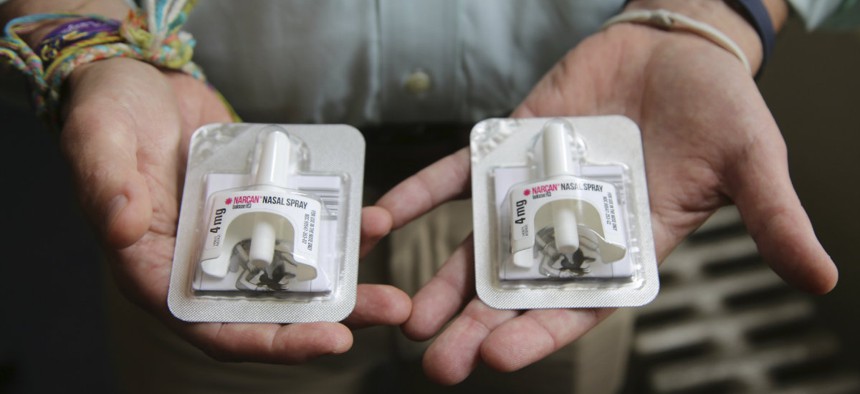New Study Shows We’re Missing Opportunities to Help Survivors of Opioid Overdoses

Narcan is an overdose-reversing nasal spray drug. (AP Photo/G-Jun Yam)
Opioid users in Pennsylvania were still being prescribed powerful painkillers, even after they were treated for an overdose.
The data related to opioid overdose deaths is grim. The drugs killed more than 33,000 people in the United States in 2015 alone. And recent studies show that, due to oversights during data collection, the actual number of fatalities could be as much as 24 percent higher.
But, not every overdose results in a death. In fact, researchers estimate that for every fatal opioid overdose, there are approximately 30 non-fatal overdoses.
Many public health officials, physicians and patient advocates view these non-fatal overdoses as prime opportunities for an intervention, a chance to get the patient into treatment and to stop the cycle of addiction.
But, research suggests those interventions aren’t happening often enough.
In a new study published as a letter on Tuesday in the Journal of the American Medical Association, researchers looked at Medicaid claims in Pennsylvania from 2008 to 2013 for more than 6,000 enrollees who had received treatment for a heroin or prescription opioid overdose.
The researchers found that the number of patients who filled an opioid prescription after a prescription opioid overdose dropped by a mere 6.5 percentage points. For patients who had experienced a heroin overdose, the filling of opioid prescriptions fell by just 3.5 percentage points compared with the period before the overdose.
And the data on medication-assisted treatment—the gold standard for evidence-based addiction intervention—for that same group following an overdose are just as underwhelming. For the group that had overdosed on heroin, MAT increased by just 3.6 percentage points. The increase in MAT is even more discouraging for the those who had experienced an overdose related to prescription opioids. In that group, MAT usage increase by only 1.6 percentage points.
The researchers concluded that, overall, the data points to “a relatively weak health system response to a life-threatening event.”
Addressing Gaps in Care
This shouldn’t be news for state and local health officials. In many states across the nation, including Pennsylvania, lawmakers have already recognized that patients who are treated for an overdose in emergency rooms need more than just a pamphlet about the dangers of addiction and a handshake. And, many of these jurisdictions are investing money and personnel in beefing up what’s called a “warm handoff,” where a patient is transferred directly and as quickly as possible from an ER to a treatment program.
In December 2016, Pennsylvania Gov. Tom Wolf issued guidance to emergency room doctors and healthcare professionals on creating warm handoff systems and hospitals across the state took notice. Reading Health System, located in Reading, unveiled its program in February.
That hospital now has addiction experts on call to help get emergency room patients who suffer from substance abuse disorders on the path to treatment. And, in the four-month period after the start of their own warm handoff program, WellSpan York Hospital in York, has sent 14 of the 60 overdose survivors they have treated into treatment.
“Ensuring overdose victims and other patients who seek help for opioid use disorders get into treatment is essential,” Pennsylvania Physician General Rachel Levine said in a statement when Wolf’s warm handoff guidance was first released. “One of the best ways to help people enter treatment is for them to be properly identified by doctors and other medical personnel when they arrive in an emergency room, and referred immediately to treatment.”
But, Levine has also admitted that in Pennsylvania, as in other states, warm handoffs can do little to help when treatment options themselves remain limited.
Does Protecting Privacy Hurt Patients?
The results of the study don’t just point to missed opportunities in hospitals. The data also indicate gaps at the policy level, particularly when it comes to privacy policies.
“What really stands out,” David K. Kelley, chief medical officer for Pennsylvania’s Medicaid program, told the Philadelphia Inquirer was that enrollees who survived an overdose “continued to be able to get medications prescribed.”
The state and federal privacy policies that govern what hospitals can and cannot disclose about their patients are particularly strict when it comes to cases of drug and alcohol abuse. Emergency rooms, for example, are not allowed to disclose information about past overdoses to outside physicians without written consent, leaving the primary care doctors who prescribe opioid painkillers in the dark about their own patients’ medical histories.
So, while systems like prescription drug monitoring programs may help doctors identify patients who are receiving prescriptions for painkillers from other providers, they would be unable to tell if their patient had received treatment for an opioid-related overdose in the past.
Some lawmakers have already proposed making changes, or issuing additional guidance when it comes to these privacy laws. One of the preliminary proposals presented by the White House’s opioid commission, which is chaired by New Jersey Gov. Chris Christie, would alter the Health Insurance Portability and Accountability Act of 1996, or HIPAA, so physicians can notify close relatives and other health provider’s when a patient's overdose is reversed with the drug Narcan.
Those privacy policy changes may still be a long way off, and it’s not yet possible to evaluate what kind of impact the increase in warm handoff programs may be having on getting overdose survivors the kind of help they need. But the authors of the study hope their research will be helpful in showing hospitals and health officials that further improvements can and must be made.
An overdose “is a time when people are vulnerable, potentially frightened by this event that's just occurred and amenable to advice, referral and treatment recommendations," Julie Donahue, associate professor of health policy and management at the University of Pittsburgh and the senior author of the paper, told National Public Radio. "It's safe to characterize it as a missed opportunity for the health system to respond."
Quinn Libson is a Staff Correspondent for Government Executive's Route Fifty, based in Washington, D.C..

NEXT STORY: Tropical System Headed to Gulf Coast Prompts Hurricane Watch and Flooding Concerns






